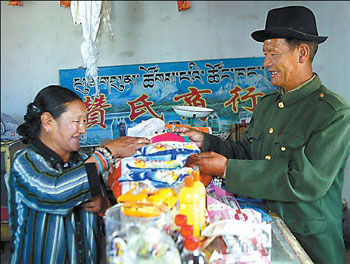Cowboys no longer roam the prairie
By Raymond Zhou (China Daily)Updated: 2007-07-17 07:06
Editor's note: Our correspondent is traveling the Qinghai-Tibet Railway. He will be sending back dispatches as he heads toward Lhasa.
 Tsantra never expected to be a shop owner. Like generations
before him, he lived the first 57 years of his life on the high-altitude
prairie, tending a dozen cows and 50 sheep.
Tsantra never expected to be a shop owner. Like generations
before him, he lived the first 57 years of his life on the high-altitude
prairie, tending a dozen cows and 50 sheep.
All that changed when the government marked a wide swath of plateau for protection as the origin of three of China's mightiest rivers - the Yangtze, the Yellow and the Lancang, known as the Mekong in Southeast Asia.
Tsantra finds the notion of safeguarding the natural habitat of the rigin of three rivers quite elusive. For him, the big draw was a free house built by the government.
The 62-square-meter abode is by no means spacious, but it shields Tsantra, his wife, their 14-year-old daughter, and his wife's 80-year-old mother from the elements much more effectively than his tent.
Now 60, the ethnic Tibetan stands in the courtyard in a village in the southern suburb of Golmud, the industrial city at the Qinghai end of the Qinghai-Tibet Railway. His store is a shack in a corner of the courtyard.
There are eight or nine similar small stores in this village of 128 households, all like Tsantra's, which entails competition and precludes Tsantra from making a small fortune for his entrepreneurship.
"I can make four to five thousand yuan ($529-660) a year, which is more than the 3,000 ($397) I made as a herdsman," he said in Chinese, with a thick Tibetan accent.
But up in the mountain, he didn't need to pay for electricity, telephone or tap water, none of which was available to a nomadic herdsman. To ease the hardship of transition, the government gives each family an annual subsidy of 6,000 yuan ($793). For thousands of years, ethnic Tibetans have roamed the Qinghai-Tibet Plateau, subsisting on herding. But the fragile ecology provides the water resources for a significant part of China and the task of keeping it pristine is becoming increasingly difficult.
The government's ideal scenario is to move all the herdsmen from the plateau - thousands of them. But that means uprooting them, forever changing their way of life.
|
A customer buys goods at the shop owned by Tsantra (right). Zhang Wei |
A fund of 7.5 billion yuan ($1 billion) has been established for the project. This includes the 30 million ($3.9 million) invested in Source of Yangtze River Village, Tsantra's resettlement just outside the toll gate in southern Golmud. Life for a resettler is a mixture of joy and anxiety. Tsantra is glad he made the 420-kilometer move in 2004 because, he explains, "I was getting older and living in a tent at 4,500 meters above sea level is hard for the health of an old person. Now we have settled down in a 2,780-meter new village with modern conveniences."
As a matter of fact, a few resettlers went back to the mountain, where they can still get a yearly subsidy of 3,000 yuan. Local officials emphasize that all families are free to choose their place of living and no coercion was used for resettlement.
"There are some 50 more households that have applied to come down from the mountain and are on the waiting list," said Zhang Xianlin, the village chief. "Besides, most who moved back and forth ended up settling in the new village."
Looking at his new and ever improving community, Tsantra knows his daughter will live a better life. In his heart, he still regrets that his is the last generation of shepherds and cowboys, and he doesn't feel like a Golmud resident. But "for the sake of the country and the environment, I understand this is necessary," he says.
(to be continued)
(China Daily 07/17/2007 page6)
|
||
|
||
|
|
